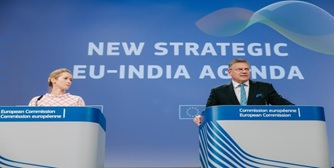13 October, 2025
EU–India New Strategic Agenda (2025)
Wed 29 Oct, 2025
Context:
- In October 2025, the European Union (EU) and India adopted a forward-looking framework titled the “EU–India New Strategic Agenda (2025)”, aiming to redefine bilateral cooperation for the coming decade.
- One of the most significant outcomes under this framework is the agreement to link the Indian Carbon Market (ICM) with the EU’s Carbon Border Adjustment Mechanism (CBAM), marking a historic step toward global climate coordination.
- This initiative not only strengthens India–EU relations but also positions both as global leaders in sustainable trade, technology innovation, and green transition efforts.
Background:
- The new agenda builds upon the foundation of the “EU–India Strategic Partnership: A Roadmap to 2025” signed in 2020.
- That roadmap had focused primarily on trade, connectivity, and sustainable development.
- The new version expands this collaboration to include critical sectors such as defence, digital governance, energy transition, and climate finance, aligning with India’s Viksit Bharat@2047 vision and the EU’s Green Deal goals.
Core Objectives of the EU–India New Strategic Agenda (2025):
-
- Promote Sustainable Prosperity: Both sides aim to work together on clean energy transitions, renewable technologies, and green hydrogen initiatives to achieve carbon neutrality.
- Enhance Strategic Autonomy: Strengthen security cooperation in the Indo-Pacific, focusing on cybersecurity, maritime awareness, and joint naval exercises.
- Deepen Technological & Digital Collaboration: Cooperation in semiconductors, 5G/6G standards, Artificial Intelligence (AI) ethics, and quantum computing.
- Establish data protection and privacy frameworks based on transparency and accountability.
- Strengthen People-to-People Ties: Expand academic exchange programs, mutual skill recognition, and student mobility under Erasmus+ and GIAN initiatives.
- Promote Global Governance & Trade Equity: Create fair and inclusive institutional mechanisms for global trade, emphasizing carbon pricing, sustainability, and fair taxation.
Five Key Pillars of the Agenda:
| Pillar | Focus Area | Objective |
| 1. Prosperity & Sustainability | Clean energy, climate finance, carbon markets | Promote sustainable and inclusive growth |
| 2. Technology & Innovation | Digital public infrastructure, AI, quantum tech | Drive ethical and transparent innovation |
| 3. Security & Defence | Indo-Pacific cooperation, cybersecurity, maritime domain | Strengthen joint security and strategic autonomy |
| 4. Connectivity & Global Issues | EU’s Global Gateway & IMEC corridor | Enhance global supply chains and trade linkages |
| 5. Enablers across Pillars | Institutional capacity, education, people-to-people ties | Deepen collaboration and shared values |
Landmark Feature – Linking Indian Carbon Market with EU’s CBAM:
- The decision to connect the Indian Carbon Market (ICM) with the EU’s Carbon Border Adjustment Mechanism (CBAM) marks a major breakthrough in North–South climate cooperation.
This will:
- Allow carbon price deduction at EU borders for Indian exports meeting emission standards.
- Encourage Indian industries to adopt low-carbon manufacturing practices.
- Strengthen India’s participation in global carbon trading under the Carbon Credit Trading Scheme (CCTS), 2023.
Significance of the Agreement:
- Strategic Balance: It reinforces India’s growing role as a key strategic partner of the EU in the Indo-Pacific.
- Climate Leadership: Joint commitment to global carbon neutrality by 2050.
- Economic Boost: Enhanced access for Indian goods to European markets under green trade norms.
- Technology Transfer: Promotes clean technology and innovation cooperation.
- Security Collaboration: Strengthens naval, cyber, and defence interoperability in the Indo-Pacific region.
Way Forward:
- The EU–India New Strategic Agenda (2025) symbolizes a transformative partnership between the world’s two major democracies.
- By aligning their policies on green energy, digital transformation, and global governance, the partnership aims to shape a multipolar, rule-based, and sustainable international order.
- The success of this framework will depend on consistent implementation, balanced trade agreements, and mutual technological investments.
European Union (EU)
- Headquarters: Brussels, Belgium
- Founded: 1957 (Treaty of Rome)
- Number of Member States: 27
- Official Currency: Euro (€) – adopted by 20 member countries
- Official Motto: “United in Diversity”
- President of the European Commission: Ursula von der Leyen
- President of the European Council: Charles Michel
- Main Institutions: European Parliament, European Commission, European Council, Court of Justice, European Central Bank
- Major Policy Framework: European Green Deal, Common Foreign & Security Policy, Single Market Policy
- India–EU Partnership Milestones: Strategic Partnership (2004), Roadmap to 2025 (2020), New Strategic Agenda (2025)


















